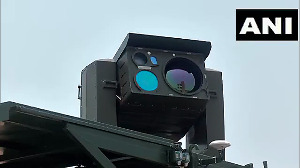Part I: Calculate your income in 10 minutes!
"If you beat us in a game of cricket, we will forgive your tax for three years. If you lose, you'll have to pay triple the taxes."
This was the condition the British administrator put before Bhuvan (Aamir Khan) in the film Lagaan. The Lagaan episode holds true even for you! Some of your tax is waived if you invest in specified areas.
This is the crux of allowing deductions from your gross total income. The smaller the income on which tax is levied, the lesser is the tax. Under Section 80C of the Income Tax Act, you can reduce your total income by up to Rs 100,000 by making specified investments. There are other sections of the Act as well wherein you can reduce your total income. These investments are mentioned below.
1. Section 80C products
Bank deposits: Term deposits in a scheduled bank with a minimum period of five years notified under the Bank Term Deposit Scheme, 2006, not only give you a fixed and assured return (around 8 per cent), but also a tax advantage.
Term deposits are a one-time investment and there is no commitment to pay in the future. But remember that the entire interest income from such deposits is taxable. State Bank of India and HDFC currently offer 8 and 7.75 per cent interest, respectively, over five years, while ICICI Bank offers 8.25 per cent.
Employee Provident Fund: This is a forced saving for employees and helps them save for retirement. Every month, 12 per cent of your basic salary is deducted and put into a kitty maintained either by the government or your company's trust.
| 7 Deductions | Deductions available | ||
| Amount | Your numbers (in Rs) |
Sections | When, where and how much of deductions |
|
Rs 20,000 -- Insurance premiums |
|
80C |
Rs 1 lakh in specified instruments like life insurance and ELSS |
|
Rs 70,000 -- Public provident fund |
|
80CCC |
Pension plans of life insurance companies; 80C limit stands reduced by 80CCC investment |
|
Rs 10,000 -- Invetsment in ELSS |
|
80D |
Rs 10,000 deduction on mediclaim, Rs 15,000 for senior citizens |
|
Rs 10,000 -- Medical Insurance Premiums |
|
80DD |
Rs 50,000 reduced from total income of a person with a handicapped dependent |
|
Rs 5,000 -- Donations |
|
80DDB |
Rs 40,000 and Rs 60,000 (sr citizen) deduction for expenditure on treatments of special diseases |
|
Rs 0 -- Other deductions |
|
80E |
Interest on education loan - entire amount tax deductible |
|
|
|
80G |
Donations (all donations don't qualify for 100% deduction) |
|
|
|
80GG |
Deduction according to formula for rent paid for housing |
|
Rs 1,15,000 -- Total Deductions |
|
80U |
Rs 50,000 deduction from total income for handicapped persons |
The contribution currently earns a tax-free return of 8.5 per cent. The rate of return is fixed by the government every year in March-April. Your employer also pitches in with 12 per cent of your salary every month. Of this, 8.33 per cent is diverted to your pension fund, the remaining amount is put in the provident fund.
Public Provident Fund: This is a self-directed investment option. It is essentially a 15-year investment that gives a tax-free return of eight per cent as of now. The rate is subject to change. Investments of Rs 500-70,000 qualify for a tax deduction under Section 80C.
Home loans: The total amount eligible for deduction is up to Rs 100,000 a year for the principal amount
Children's fees: Parents can claim a deduction for tuition fees for a maximum of two children within the overall limit of Rs 100,000. However, payment towards development fees or donations to the institution are excluded.
National Savings Certificates: These are for those who are less averse to risk. This government-backed security is available at post offices and gives an interest rate of eight per cent, compounded half-yearly as of now. The interest is entirely taxable. NSCs are good for those in lower tax slabs with an investment horizon of six years.
Equity-linked savings schemes: These are mutual fund products and carry market risk. Like all tax saving options, these plans have a lock-in period of three years. Therefore, it makes sense to go in for funds with good track records rather than the new fund offers, especially in this category. Choose the 'growth' option for an optimal investment.
Life insurance: Your life cover premium is eligible for a tax deduction up to Rs 1 lakh under Section 80C. If the premium paid in any of the years is more than 20 per cent of the sum assured, then deduction will be allowed only up to 20 per cent of the sum assured. This applies to all term, endowment and unit-linked plans.
Pension plans: If any investment is made under this section, then the qualifying amount under Section 80C stands reduced to that extent. Investment in insurance and mutual fund pension plans also comes under this section with an overall limit of Rs 1 lakh.
|
8 Section 80C investments | ||||
|
Plans available |
Interest (%/yr) |
Tenure (yrs) |
Tax status of returns |
Features |
| Bank fixed deposit |
8 |
5 |
Entirely taxable |
Deposits up to Rs 1 lakh per bank per branch insured |
| Employee Provident Fund |
8.5** |
Till superannation |
Tax free |
Interest is normally announced every April |
| National Savings Certificate |
8 |
6 |
Entirely taxable |
Highest safety |
| Public Provident Fund |
8** |
15 |
Tax free |
Withdrawals, loans available |
| Equity-linked savings schemes |
Market linked |
3 minimum |
Tax-free |
Dividend and capital gains are tax-free |
| Life insurance - endowment |
IRR of 4-7 |
10-30 |
Tax-free |
Life insurance cover |
| Life insurance - unit linked |
Market linked |
5-30 |
Tax-free |
Life insurance cover |
| Pension plan (insurance) |
Market linked |
Till age 45 |
Pension taxable |
Benefit u/s 80CCC within overall limit of 80C |
| UTI - Retirement Benefit Pension Fund |
Balanced Fund |
Till age 58 |
Capital gains tax |
Returns (%) over 3/5 years^15.0/17.0 |
| Templeton India Pension Plan |
Balanced fund |
Till age 58 |
Capital gains tax |
Returns (%) over 3/5 years^16.1/20.1 |
|
*May vary for each company **Current rate of interest *** Subject to attaining a minimum investment of Rs 10,000/- by the age52 years ^As on 16 jan 2007 |
2. Other deductions
Health insurance: Under Section 80D, medical cover premium is tax-deductible up to Rs 10,000, with an additional deduction of up to Rs 5,000 if the policy is in the name of a senior citizen (65 years or older) and the premium is paid by him. If someone below 65 buys a plan for his dependents, he can avail benefit upto Rs 15,000.
Educational loan: The interest on loans taken for higher education are also eligible for deduction from your total income under Section 80E. There is no monetary ceiling on the interest you can claim as a deduction. The loan must have been taken from a financial institution or an approved educational institution. Remember, repayment of loan or interest on loans taken by parents for higher education of their child is not eligible for deductions.
|
9 Taxable income | ||||
|
Amount |
Your numbers (Rs) | |||
|
Gross total income | ||||
|
Rs 11,83,999 |
| |||
|
Rs 1,15,000 Less |
| |||
|
Rs 10,68,999 Taxable income |
| |||
|
The calculations are indicative and do not exhaust all possibilities | ||||
Charity: To avail tax benefits under Section 80G, donations must be made only to specified trusts. The tax breaks vary according to the trust to which you have donated.
Medical treatment: Any expenditure for the medical treatment (including nursing) of a handicapped person, training and rehabilitation of a person suffering from a permanent physical disability (including blindness) or from mental retardation, qualifies for a deduction under Section 80DD upto Rs 50,000. A life insurance policy bought for the benefit of such a handicapped person is also eligible for this benefit up to Rs 50,000. In case the disability is severe, the claim can go up to Rs 75,000.
What to do: US radio comedian Fred A. Allen once said, "An income tax form is like a laundry list - either way you lose your shirt." The law, indeed, takes its own course, and cares little whether you are left with your shirt on or not. But the law just became better this year, by removing caps on investments in the avenues mentioned above, except for PPF, where deductions are available only up to Rs 70,000. Thus, investors can invest in line with their risk appetites and needs.
Investments in tax instruments should never be done merely to save taxes. The value derived through liquidity, returns and security over the next few years should guide your investment decision.
The Income Tax Act does not treat all kinds of savings uniformly - the taxability of contributions, accumulations and withdrawals differs from one instrument to another. In a PPF scheme, for instance, you can avail deductions, and the interest and the money you get on maturity is not taxed. This is the 'exempt-exempt-exempt' method of taxation, since all three stages - contribution, accumulation and withdrawal - are exempt from tax.
On the other hand, while contributions to, and accumulations in pension plans are not taxable, lump sums withdrawn or periodical pension are taxed in the year of receipt. This is the 'exempt-exempt-tax' method of taxation.
Don't forget to keep the records of your investments and tax deduction certificates, since you will have to attach them with your returns.
If you think the tax rates are skewed, American explorer Jeff Rich will give you company. He said: "We are all are equal, but some pay higher tax rates than others." And you thought tax was invented to make life fair for everybody.
|
6 - 7 = 9 = Taxable Income |
DON'T MISS TOMORROW: Calculate your tax, in 5 minutes flat!







 © 2025
© 2025